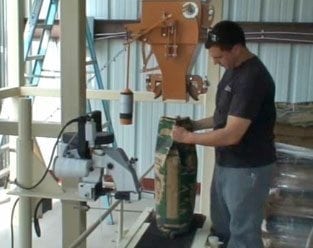A producer of wood stoves in New York was seeking an open-mouth bagging machine to package 3,000 pounds of wood pellets into 40-pound plastic bags to match the production rate of their pellet milling process. They wanted a system that would be fast, weight accurate, and economical. Additionally, the only available electrical power at the facility was single phase so all equipment had to be designed to operate on 220 volts single phase.
The Recommended Open Mouth Bagging Machine Solution
To achieve the client’s objectives, Choice Bagging Equipment recommended a system featuring a Model GWB open mouth bagger and an in-line band sealer system. Product was fed to the bagging machine by an overhead supply hopper that held approximately 1,500 pounds of material. The system required two operators. One operator places empty bags on the filling machine and guides them through the sealer machine. The second operator palletizes the filled bags at the end of the line.
The Model GWB bagging machine featured an integrated digital weighing scale that started at the press of a foot pedal by the system operator. It stops and releases from the filler once the target weight had been achieved. Filled bags were automatically discharged onto a specially designed bag closing conveyor and transferred to and through a continuous band sealer that provided 100% positive bag closure. A sealer integrated bag trimmer provided a uniform look to the sealed end of each bag. Sealed bags were elevated to waist high on a powered belt conveyor and palletized by a second system operator at the end of the packaging line.
A Semi-Automatic System
Each filling sequence was semi-automatic meaning that an operator would manually hang each bag, depress a foot pedal and then it would be filled to a pre-programmed weight, stop filling and release automatically. The filling machine had an integrated weighing scale, which worked in combination with a single PLC-based control package. The weighing controls were specially designed for valve bag filling applications and featured a gain-in-weight totalizing display. The controls were designed with the ability to communicate weight data to a printer or central management control system.
An air-operated bag clamp securing the bag to the filling spout without the operator having to manually secure it to the filling spout, which sped up production dramatically.
The flow of material was automatically started and stopped by a variable 3-position gate valve (called a gravity gate). The integrated digital control and the weighing system would signal the pneumatic functions of the machine on and off in the correct sequence including the pneumatic gate valve would regulate the amount of material into the bag.


Recent Comments